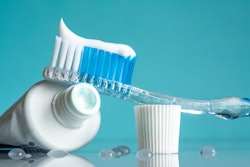
The calcium fluoride phosphate fluorapatite (FA) or zinc-doped FA (ZnFA) showed potential as effective bone fillers for treating tooth defects. The study was published on May 11 in the Journal of Dentistry.
Additionally, they may serve as a substitute for autograft materials, which are the current gold standard in restorative dentistry, the authors wrote.
"These materials could serve as viable substitutes for bone regeneration, serving as artificial, off-the-shelf bone fillers," wrote the authors, led by Jill Shea, PhD, of the Orthopedic and Plastic Surgery Research Laboratory at the George E. Wahlen Department of Veterans Affairs Medical Center in Salt Lake City.
Despite the routine use of autografts, demineralized bone matrix, allografts, bovine-derived bone grafts, and other fillers, between 40% and 60% of the alveolar ridge is resorbed within the initial two to three years after tooth extraction. This leaves the space without viable bone tissue necessary for subsequent dental restorations.
Although autografts are considered the best to use to regenerate bone, its use as filler for dental implants is limited. Autograft harvest requires much more sterile operative procedures and procurement can be costly. Due to these limitations, demineralized bone matrix is often used. However, its use is also limited by supply and growing demand.
FA and 2% ZnFA (2ZnFA) were made, compressed into discs, and incubated with bacteria to assess antibacterial properties. Adipose-derived stem cells were cultured on these discs, and the surfaces that showed the highest expressions of bone markers -- osteopontin and osteocalcin -- were used in an in vivo study.
Next, 20 rats were separated into five groups and were given a 5-mm defect in the jaw. The defect was left untreated, filled with 2% ZnFA, FA, an autograft, or demineralized bone matrix. At 12 weeks, the defects and surrounding tissues were harvested and underwent microcomputed tomography (MicroCT) and histological evaluations, according to the study.
Though bacterial studies showed no significant differences in surface bacterial adhesion properties between FA and 2% ZnFA, it revealed considerably fewer bacterial loads than control titanium discs (p < 0.05). Both surfaces could support cell growth and promote the osteogenic differentiation of stem cells based on cell culture data.
Furthermore, imaging analysis confirmed statistical similarities in bone regeneration among fluorapatite, zinc-doped fluorapatite, and autograft groups, they wrote.
Nevertheless, the study had limitations, including the technique used to measure bone percentage within the rat dental defect model. More research is needed to improve the accuracy of MicroCT (μCT) volume rendering for these bone assessments, the authors wrote.
In mandibular defects, these materials led to bone regeneration. However, more translational research may be needed to confirm FA-based materials as superior substitutes for existing synthetic bone fillers, which would ultimately improve patient outcomes, they wrote.
"Despite 2ZnFA not showing significantly enhanced antimicrobial properties compared to FA alone, it remains a practical choice for dental applications, especially considering the increased morbidity associated with autograft harvest and known limitations of allo- and xeno- graft use in dentistry," Shea et al wrote.




















